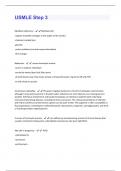USMLE Step 3
Riboflavin deficiency - Riboflavin=B2
-angular stomatitis (changes at the angles of the mouth)
-cheilosis (cracked lips)
-glossitis
-ocular problems (corneal neovascularization)
-skin changes
Babesiosis - -causes hemolytic anemia
-severe in asplenic individuals
-carried by Ixodes (deer) tick (like Lyme)
-dx with blood smear that shows tetrads of intraerythrocytic ring forms OR with PCR
-tx with clinda or quinine
Aeromonas hydrophila - This gram-negative bacterium is found in freshwater environments,
although it may also be present in brackish water. Infections are more likely to occur during warmer
weather. Soft tissue involvement and bacteremia/sepsis can develop in patients with underlying
immunocompromising diseases, including cirrhosis and cancer. The clinical presentations of infection
with Vibrio vulnificus and Aeromonas species can be quite similar. This organism is often susceptible to
fluoroquinolones, trimethoprim-sulfamethoxazole, tetracyclines, imipenem, aminoglycosides, and third-
or fourth-generation cephalosporins
5 causes of microcytic anemia - iron deficiency, lead poisoning, anemia of chronic disease (but
usually normocytic), thalassemia, sideroblastic anemia (can also have high MCV)
Abx safe in pregnancy - -PCNs
-cephalosporins
-aztreonam
-erythromycin
,-azithromycin
Abx with NO anaerobic coverage - aminoglycs, aztreonam, fluoroquinolones, oxacillin/nafcillin, all
cephalosporins EXCEPT cefoxitin and cefotetan
Acanthocytes on blood smear (looks like spur cell but with more rounded spurs) - liver disease,
hypothyroidism, alcoholism
Achalasia - -high tone LES
-bird's beak on barium swallow
-histology shows hypertrophied inner circular muscle with absence of ganglia of Auerbach's plexus
-tx with balloon dilation or surgery
Actinomyces - -normal immune system w/ facial or dental trauma
-dx with gram stain and confirm with anaerobic cx
-branching, filamentous bacteria (LIKE nocardia!)
-tx with PCN
Adequacy of sputum sample - <10 squamous cells and >25 leuks per LPF
Adjustment of levothyroxine in pregnancy - -INCREASE dose as soon as pregnancy is confirmed
-most pt.s require increase of 25-50%
-check TSH once a trimester
-checking T3 and T4 not effective b/c these levels are increased during pregnancy due to increased
thyroid-binding globulin
Adverse effects of NNRTIs - ??
efavirenz
,nevirapine
Adverse effects of NRTIs - lactic acidosis
zidovudine: anemia
didanosine: pancreatitis and peripheral neuropathy
stavudine: pancreatitis and neuropathy
lamivudine: none
abacavir: rash
emtricitabine: none
Adverse effects of protease inhibitors - hyperglycemia
hyperlipidemia
indinavir: kidney stones
ritonavir
lopinavir
nelfinavir
saquinavir
darunavir
tipranavir
amprenavir
atazanavir
Alcoholic ketoacidosis - -AG acidosis
-increased osmolal gap
-ketonemia or ketonuria
-variable blood glucose level, but if higher than 250 think DKA
, -tx with IVF (D5NS) and thiamine
Alcoholic with PNA - strep pneumo, oral anaerobes, Klebsiella pneumo, Acinetobacter, M.
tuberculosis
Anaerobes - -metronidazole is BEST for abdominal anaerobes (carbapenems, piperacillin, and
ticarcillin have equal efficacy)
-cefoxitin and cefotetan are the ONLY cephalosporins
-respiratory anaerobes: clindamycin
Antibiotics for GNRs - Cephalosporins: cefepime, ceftazidime
PCNs: piperacillin, ticaricillin
Monobactam: Aztreonam
Quinolones: cipro, levo, gati, moxi
Aminoglycs: gentamicin, tobramycin, amikacin
Carbapenems: imipenem, mero, erta
Antibiotics for MRSA - IV: vanc, linezolid, daptomycin, tigecycline;
if minor infection, can use oral: TMP/SMX, doxy, minocycline, or maybe clindamycin (there is inducible
resistance to clinda though)
Antibiotics for MSSA - Oxacillin/nafcillin, dicloxacillin (IV and oral), cefazolin (IV), cephalexin (oral)
Antibiotics for strep - PCN, ampicillin, amoxicillin
Antibiotics to use for Staph with PCN allergy - cephalosporins if rash only; macrolides,
clindamycin, vancomycin, linezolid, daptomycin, TMP/SMX
Antibody test for celiac disease - anti-endomysial, tissue transglutaminase (small bowel bx is best
though)




